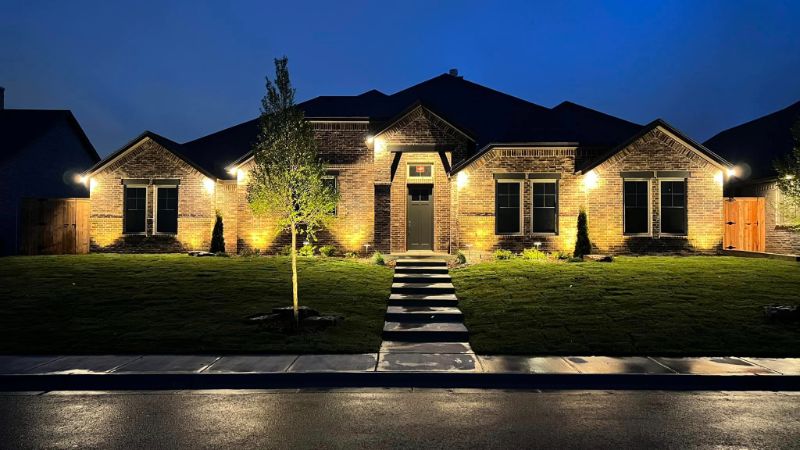Understanding Color Temperatures and Their Role in Outdoor Lighting
When considering outdoor lighting for your home or business, one of the most important decisions you'll make is selecting the right color temperature. Color temperature not only affects the appearance of your property but also influences the mood, safety, and functionality of your outdoor spaces. This article will explain what color temperatures are, how they work, and how to choose the best color temperature for your outdoor lighting needs. We’ll also discuss how smart-controlled LED lighting systems allow you to adjust the color temperature on the fly, offering unparalleled flexibility and customization.
What is Color Temperature?
The Basics of Color Temperature
Color temperature is a way to describe the light appearance provided by a bulb, measured in degrees Kelvin (K) on a scale from 1,000 to 10,000. It’s a critical factor in lighting design because it affects how colors are perceived and the overall ambiance of a space.
- Warm Light (Below 3,000K): Light with a color temperature below 3,000K is considered warm. It has a yellowish or reddish hue similar to the light emitted by incandescent bulbs or candlelight. Warm light is typically used in settings where a cozy, inviting atmosphere is desired.
- Neutral Light (3,000K to 4,000K): Neutral light ranges from 3,000K to 4,000K and has a more balanced white appearance. It’s neither too warm nor too cool, making it a versatile option for various applications, especially in settings where accurate color representation is important.
- Cool Light (Above 4,000K): Light above 4,000K is considered cool. It has a bluish tint and is often associated with daylight or fluorescent lighting. Cool light is bright and crisp, making it ideal for task-oriented settings or areas where visibility is crucial.
How Color Temperature Works
Color temperature is determined by the type of light source and its filament or diode composition. For example, traditional incandescent bulbs have a lower color temperature because they emit light by heating a tungsten filament, which produces a warm, yellowish glow. In contrast, LED lights can be engineered to produce a wide range of color temperatures by adjusting the combination of phosphors and the type of semiconductor material used in the diodes.
LEDs are particularly versatile because they can be designed to emit specific color temperatures, offering more control and customization compared to older lighting technologies. This versatility is one of the reasons why LEDs have become the preferred choice for modern outdoor lighting systems.
Choosing the Right Color Temperature for Outdoor Lighting
Warm Light: Creating a Cozy and Inviting Atmosphere
Warm light, typically ranging from 2,700K to 3,000K, is ideal for creating a welcoming and comfortable environment. It’s often used in residential settings, such as patios, decks, and garden areas, where you want to foster a sense of relaxation and intimacy.
Best Applications for Warm Light
- Residential Patios and Decks: Warm light enhances the natural tones of wood and stone, making it perfect for outdoor living spaces where you entertain guests or relax with family.
- Garden Lighting: Use warm light to highlight plants, flowers, and trees, creating a serene and soothing atmosphere in your garden.
- Outdoor Dining Areas: Warm lighting helps create a cozy, inviting ambiance, making it perfect for outdoor dining areas where comfort and relaxation are key.
Neutral Light: Versatility and Balanced Illumination
Neutral light, in the 3,000K to 4,000K range, offers a balanced white light that’s neither too warm nor too cool. This makes it a versatile option for both residential and commercial settings where accurate color rendering and a natural appearance are important.
Best Applications for Neutral Light
- Walkways and Pathways: Neutral light provides clear visibility without overwhelming brightness, making it ideal for lighting pathways and walkways around your property.
- Commercial Entrances: Neutral light is welcoming and professional, making it a great choice for illuminating the entrances of businesses and commercial properties.
- General Outdoor Lighting: Use neutral light for general outdoor illumination, such as lighting up building facades or parking areas, where you need consistent and reliable lighting.
Cool Light: Enhancing Visibility and Security
Cool light, with color temperatures above 4,000K, is known for its bright, crisp quality. It’s often used in settings where visibility and security are the primary concerns. The bluish tint of cool light can make spaces appear more alert and focused, which is why it’s commonly used in task-oriented areas.
Best Applications for Cool Light
- Security Lighting: Cool light is ideal for security purposes, as it provides bright, clear illumination that helps deter potential intruders and enhances surveillance camera footage.
- Commercial Parking Lots: In commercial settings, cool light ensures that parking lots and loading areas are well-lit, reducing the risk of accidents and improving safety for employees and customers.
- Task Lighting: For outdoor workspaces or areas where detailed tasks are performed, cool light provides the clarity needed to work efficiently.
The Role of Smart-Controlled LED Lighting Systems
Customizing Color Temperature with Smart Controls
One of the most significant advancements in outdoor lighting technology is the integration of smart controls with LED lighting systems. Smart-controlled LED lighting allows you to adjust the color temperature and brightness of your lights with the touch of a button, offering unmatched flexibility and customization.
How Smart Controls Work
Smart lighting systems are typically connected to a central hub that allows you to control your lights through a smartphone app, remote control, or voice commands via smart home devices like Amazon Alexa or Google Assistant. These systems allow you to change the color temperature on the fly, set schedules, and create custom lighting scenes that can be activated with a single command.
Benefits of Smart-Controlled Lighting
- Adaptability: With smart controls, you can easily switch between warm, neutral, and cool light depending on the time of day, activity, or mood you want to create. For example, you might use warm light in the evening for relaxation and switch to cool light for early morning tasks or security purposes.
- Energy Efficiency: Smart systems can be programmed to turn lights on and off automatically based on your schedule, helping to conserve energy and reduce utility bills.
- Convenience: The ability to control your outdoor lighting from anywhere adds a level of convenience that traditional lighting systems can’t match. Whether you’re at home or away, you can ensure your property is always properly lit.
Presets and Custom Settings
Smart lighting systems often come with presets that allow you to quickly choose a preferred color temperature and lighting scene. You can also create custom settings that are tailored to specific areas of your property or particular times of the day.
Examples of Custom Settings
- Evening Relaxation: A preset that uses warm light to create a cozy ambiance on your patio or deck after sunset.
- Security Mode: A preset that switches to cool, bright light in key areas like driveways and entrances to enhance visibility and deter intruders.
- Party Mode: A custom scene that uses neutral light to illuminate your outdoor entertaining spaces, making it easy for guests to navigate and enjoy the festivities.
How to Choose the Right Color Temperature for Your Property
Assessing Your Needs
The first step in choosing the right color temperature for your outdoor lighting is to assess the specific needs of your property. Consider the following factors:
- Purpose: What is the primary purpose of your outdoor lighting? Are you focusing on security, ambiance, or general illumination?
- Location: Where will the lights be installed? The ideal color temperature may vary depending on whether the lights are for a garden, walkway, or commercial entrance.
- Aesthetics: What mood or atmosphere are you trying to create? Warm light is ideal for a cozy, inviting feel, while cool light is better suited for high-visibility areas.
Consulting with a Professional
If you’re unsure which color temperature is best for your property, consider consulting with a professional lighting designer. At Holt Outdoor Lighting, we can evaluate your space, recommend the best lighting solutions, and help you understand how different color temperatures will affect the appearance and functionality of your outdoor areas.
The Importance of Choosing the Right Color Temperature
Color temperature is a critical factor in outdoor lighting design that can significantly impact the look, feel, and functionality of your property. Whether you’re looking to create a warm, inviting atmosphere for guests or ensure high visibility for security purposes, understanding how color temperature works and choosing the right one for your needs is essential.
With the advent of smart-controlled LED lighting systems, you now have the flexibility to adjust color temperatures on the fly, making it easier than ever to customize your outdoor lighting to suit any situation. By selecting the right color temperature and utilizing smart controls, you can enhance the beauty, safety, and efficiency of your outdoor spaces, ensuring that your property shines in the best possible light.
If you would you like to schedule an outdoor lighting consultation for your property please give us a call (806) 777-4949 or fill out our online contact form and someone will be getting back to you shortly to schedule your appointment.

